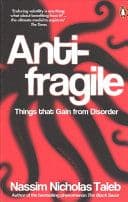
Antifragile:
Things that Gain from Disorder
Tough times don't last. Tough people do.
DIFFICULTY
advanced
PAGES
544
READ TIME
≈ 780 mins
DIFFICULTY
advanced
PAGES
544
READ TIME
≈ 780 mins
About Antifragile
The best systems don’t just survive shocks—they get stronger because of them.
Antifragile shows how to design lives, organisations and policies that benefit from volatility rather than fear it. It explains the perils of brittle forecasts, and explains how to keep most exposure boring and safe by placing small, optional bets with unlimited upside. Learn how to subtract the harmful using the philosophical/theological concept of the "via negativa". Learn to build slack and redundancy into your best laid plans; decentralise, and let small, frequent errors surface information before a catastrophic one does.
The author's practical and holistic approach to antifragility blends streetwise heuristics with risk logic to benefit all of us: from medicine, to finance, to everyday routines. Taleb shows that you may not be able to predict the storm, but you can arrange your affairs to be improved by it.
What You'll Learn
- The fragile–robust–antifragile triad and why it matters
- Systems that benefit from volatility, randomness, and stressors
- Barbell strategies to manage risk under uncertainty
- Use optionality, redundancy, and decentralization to reduce fragility
- Adopt via negativa and avoid iatrogenics in decisions and policy
- Value skin in the game to align incentives and improve outcomes
Key Takeaways
- Antifragile > robust
- Barbell strategy for risk
- Optionality beats prediction
- Via negativa: subtract to strengthen
- Skin in the game matters

